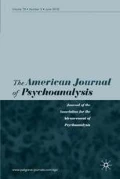Abstract
The emergence of a collective identity, a complex social and psychological process, may be linked to a specific place and a particular urban layout. Architecture demarcates interior and exterior spaces that not only frame our relationships but can also generate a mirror image of the internal world. The authors examine relevant contributions from the sparse psychoanalytic literature on this subject, to support their hypothesis that changes to a city’s landscape, design, or architecture, when wholeheartedly embraced by its citizens, can serve to forge a new collective identity that helps to deal with absence, pain, and loss. They present the city of Bilbao, Spain, as a case study. This once thriving industrial city had collapsed into economic ruin, rife with social conflict, but since the 1990s, in an urban renewal, has emerged as a unique tourist destination. It has become a modern art and cultural center, symbolized by its most famous piece of contemporary architecture.
Similar content being viewed by others
References
Angel, V. T. (2000). Transsubjectivity: The space where psychoanalysis and architecture meet. International Forum of Psychoanalysis, 9(1–2), 76–83.
Aristotle (350 BCE). Política [Politics] Madrid: Austral. 2011.
Bion, W. R. (1961). Experiencias en grupos. Barcelona: Paidós. 1980 [Experiences in groups and other papers. New York: Routledge. 2003].
Bollas, C. (2000). Architecture and the unconscious. International Forum of Psychoanalysis, 9(1–2), 28–42.
Charles, M. (2001). Auto-sensous shapes: Prototypes of creative forms. American Journal of Psychoanalysis, 61, 239–269.
Eilenberger, W. (2019). Tiempo de magos: La gran década de la filosofía: 1919–1929, J. C. Mieike (Trans.). Madrid: Taurus. [Time of the magicians: The invention of modern thought, 1919–1929. London: Allen Lane. 2020].
Esteban, I. (2007). El efecto Guggenheim. Del espacio basura al ornamento [The Guggenheim effect. From junk space to ornament]. Anagrama: Barcelona.
Freud, S. (1919). The ‘uncanny.’ Standard Edition, Vol. 17 (pp. 217–252). London: Hogarth.
Green, A. (1993). El trabajo de lo negativo [The work of the negative]. In A. Green (Ed.), Ideas directrices para un psicoanálisis contemporáneo. Desconocimiento y reconocimiento del inconsciente [Key ideas for a contemporary psychoanalysis. Discovery and recognition of the unconscious] (pp. 290–298). Buenos Aires: Amorrortu. 2005. [Originally published in French, 1993].
Greenaway, P. (Director), & Payne, D. (Producer). (1982). The draughtsman’s contract. [Motion picture]. British Film Institute and Channel Four Television. United Kingdom.
Hessel, F. (2015). Paseos por Berlin [Strolls about Berlin]. Madrid: Errata Naturae.
Iglesia Pagnotta, A. M. (2019). La revolución de las flâneuses [The revolution of the flâneuses]. Girona: Wunderkammer.
Jeffries, S. (2020). A dwelling for the gods. The unknown Wittgenstein: Architect, engineer, photographer. Exhibit at the Royal Academy of Art, London. Guardian, January 4, 2020. https://www.theguardian.com/books/2002/jan/05/arts.highereducation.
Jemstedt, A. (2000). The phase of encounter between inner and outer reality. International Forum of Psychoanalysis, 9(1–2), 124–131.
Kernberg, O. F. (2006). Identity: Recent findings and clinical implications. Psychoanalytic Quarterly, 75(4), 969–1003.
Lamott, A. (2020). Personal communication. April.
Langan, R. (2000). Someplace in mind. International Forum of Psychoanalysis, 9(1–2), 69–75.
Lefebvre, H. (1974). The production of space. Oxford: Blackwell.
Mattson, H. (2000). Spacing unpredictability. Action as an operating tool in Richard Serra’s work. International Forum of Psychoanalysis, 9(1–2), 43–50.
Merleau-Ponty, M. (1957). Fenomenología de la percepción. Barcelona: Planeta. 1993. [Phenomenology of perception. London: Routledge. 2002].
Ortega y Gasset, J. (1952). El mito del hombre allende la técnica. [The myth of the man beyond technique]. Obras Completas. Tomo IX. (pp. 617–625). Madrid: Revista de Occidente. 1965. [Original work published in 1952 in German, Darmstädter Gespräch: Mensch und Raum. Otto Bartning Publisher.]
Paterculus, V. (ca. 19 B.C.—ca. 30 A.D.). In J. C. Yardley and A. A. Barrett (Eds., and Trans.). The Roman History. From Romulus and the foundation of Rome to the reign of the Emperor Tiberius. Indianapolis, IN: Hackett Publishing.
Rachmani, G. (2019). Book Review: Cosimo Schinaia: Psychoanalysis and architecture: The inside and the outside. American Journal of Psychoanalysis, 79, 637–639.
Rodman, F. R. (2005). Architecture and the true self. Annual of Psychoanalysis, 33, 57–66.
Rousseau, JJ. (1763). Emilio o de la educación. [Emile. Or Treatise on Education.] Madrid: Groupo Anaya Publicaciones Generales. 2011.
Schinaia, C. (2014). Psychoanalysis and architecture. The inside and the outside. London: Karnac Books.
Serra, R. (1996–1999). Torqued Ellipses I, II, III, IV, V, VI. [Sculpture]. Bilbo, Spain: Guggenheim Museum Bilbao.
Volkan, V. (2013). Enemies on the couch: A psychopolitical journey through war and peace. Durham, NC: Pitchstone.
Weizman, E. (2019). The roundabout revolutions. Cambridge, MA: The MIT Press.
Wenkart, A. (1970). Spatiality—A concern for the psychoanalyst. American Journal of Psychoanalysis, 30, 145–154.
Wijdeveld, P. (1994). Ludwig Wittgenstein, Architect. London: Thames and Hudson.
Winnicott, D. W. (1953). Transitional objects and transitional phenomena. International Journal of Psycho-Analysis, 34, 89–97.
Author information
Authors and Affiliations
Corresponding author
Additional information
Publisher's Note
Springer Nature remains neutral with regard to jurisdictional claims in published maps and institutional affiliations.
Miguel Angel Gonzalez-Torres, M.D., Ph.D., Full Professor, Department of Neuroscience, University of the Basque Country, Bilbao, Spain.
Aranzazu Fernández-Rivas, M.D., Ph.D., Child and Adolescent Psychiatry, Basurto University Hospital, Bilbao, Spain.
Address correspondence to Miguel Angel Gonzalez-Torres M.D., Ph.D., Psychiatry Service, Basurto University Hospital, Montevideo Avenida 18, Bilbao, Spain 48013.
Rights and permissions
About this article
Cite this article
Gonzalez-Torres, M.A., Fernández-Rivas, A. Architecture, urban planning and collective identity: Bilbao as a case study. Am J Psychoanal 80, 383–394 (2020). https://doi.org/10.1057/s11231-020-09265-9
Published:
Issue Date:
DOI: https://doi.org/10.1057/s11231-020-09265-9




